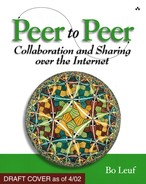Visions of Sugarplum
As the recent hype about p2p as the solution to all problems faded in late 2001, along with many of the companies most vocal about this promise, we see a residue of practical solutions out there, hard at work or in the process of being deployed.
Despite the controversy, the single-source problem, the uncertainties about security and liabilities, many companies continue to pursue, sometimes aggressively, a deployment plan for p2p of one nature or another. Efficiency, better profit, better customer relations, staking out a future market—all are powerful motivations to take the risk, and their common element is some vision of revenue. Another, perhaps larger group is pursuing the open source implementations and further developing a generic infrastructure to transform the Internet as we know it. Their immediate goal is not revenue, though as it happens the infrastructure and software might make that more attainable, but to make p2p a natural part of the digital landscape.
Granted, the use of “p2p” as a descriptor has become less popular, and as noted previously, the spring 2002 O’Reilly P2P Conference was retargeted as “emerging technologies”, without the peer focus. Perhaps this is an indication of a more considered approach to the technologies that are being discussed. Perhaps too, it is a realization that many p2p solutions don’t function in a vacuum but depend on many layers of network and infrastructure, on interoperability with traditional centralized services, and even more importantly, on unforeseen social and legal dimensions that can derail even the most promising technology.
The situation is a far cry from the high-adrenaline days of 2000/2001, when most seemed to be convinced that the combined energy of emergent dot-com startups and new Internet technology would make the global economy go straight up indefinitely—shades of inexhaustible resources, in virtual space there are no constraints! Millions of PC users suddenly had the magic horn of digital cornucopia installed right on the desktop, with uncounted terabytes of music, film, software, and virtually anything at all at their fingertips, for free.
Well, that was fun while it lasted. The world is significantly more sober in 2001/ 2002, and other issues have largely dimmed the spotlight of attention of p2p. That may be a good thing, as now only the serious and committed innovators and developers remain in the field.
So, next, let’s look at the implementations applied to practical situations and examine the usage patterns associated with p2p.
